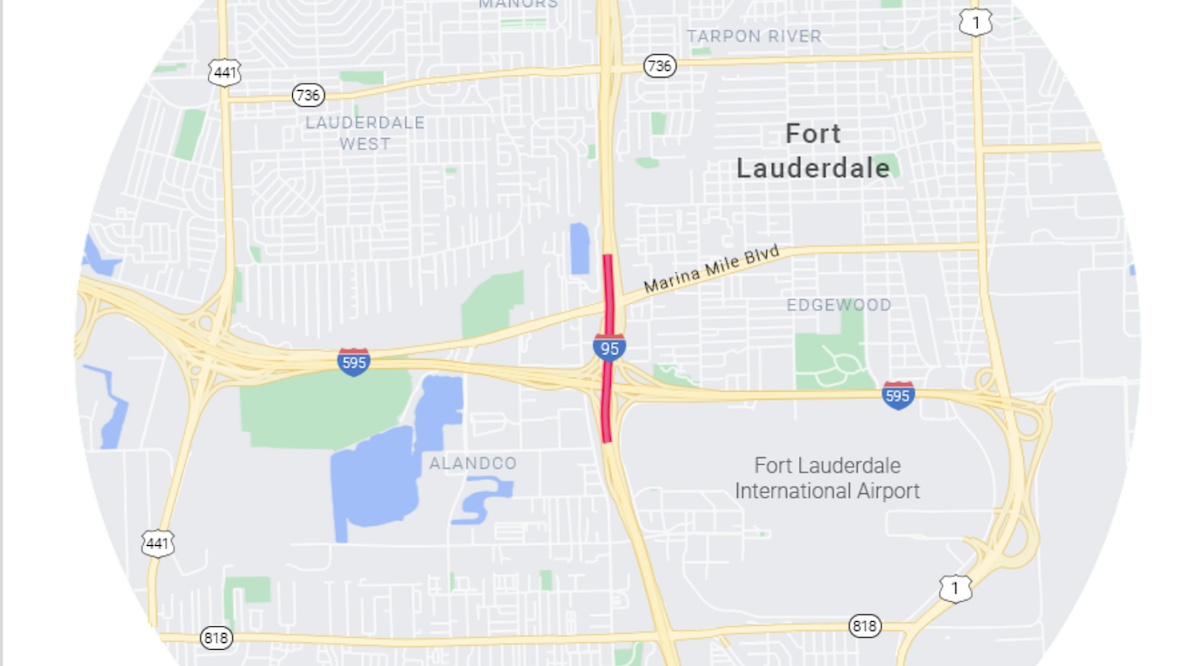
via 1 Point21 Interactive, Elk & Elk

Audio By Carbonatix
Last May, a woman driving a Mercedes-Benz SUV plunged nearly 20 feet off the southbound entrance ramp onto I-95 from State Road 84 in Fort Lauderdale. She’d hit a concrete guardrail that had just been repaired following an eerily similar accident that sent two men in a Cadillac SUV to the hospital roughly 24 hours prior.
While those three victims survived, 24 people died in 23 car crashes between 2000 and 2019 along that same stretch of I-95 between I-595 and State Road 84, which is now considered the “deadliest mile in America,” according to a new study by 1Point21 Interactive digital agency and the Elk & Elk personal injury law firm.
The study, which was published on Sunday, looked at 20 years of fatal crash data – more than 91,000 accidents in total – across the United States and found that this stretch of I-95 saw nearly 50 times the number of fatal car accidents than the average highway mile.
“I-595 is dangerous. State Road 84 is dangerous. A lot of tourists are doing 60 miles per hour in rental vehicles coming in and out of the [Fort Lauderdale International] airport – it’s a nightmare,” Mike Arias, a local public roadway safety advocate, tells New Times. “There are deficiencies that are currently claiming lives, day in and day out.”
Last March, a 48-year-old man died after flipping over the guardrail in a pickup truck on the I-95 exit ramp onto State Road 84. Fours years before that, 17-year-old Letroy Martin, Jr., died after crashing into the concrete guardrail on the I-95 exit ramp onto State Road 84. He was a senior at Fort Lauderdale High School. His father told Local10 that he was a “good kid, full of joy, loved to have fun, [and] played sports.”
Arias, a retired traffic officer for Miami-Dade Fire Rescue with 40 years of experience, points to a number of issues along this stretch of road: high speeds, complicated entrance and exit ramps, poor visibility of the roadway and overheard signs, inadequate spacing and durability of express-lane poles, and a higher percentage of drivers unfamiliar with the area coming to and from the Fort Lauderdale airport.
“The exit ramps and on-ramps are very dark and not well lit. There are not enough reflectors. It’s also a very sharp type of curb to negotiate. So if you’re not familiar with the area and you’re coming in a little faster than you should – forget it, you’re not going to make it and blow into the wall,” Arias says. “Most of these incidents do not occur during rush hour when it’s bumper-to-bumper [traffic] but when it’s dark and drivers increase their speed.”
The study also examined fatal car crashes along ten-mile stretches of highways across the U.S between 2000 and 2019. The deadliest ten-mile stretch is along I-45 in Houston. Second place goes to I-35 in Dallas. And third-deadliest is I-95 between exits 18 and 27 in southern Broward County, a stretch that includes the deadliest mile. During the 20-year window, there were 146 deaths there.
Two other South Florida roadways are featured in the study’s top-ten ranking: I-95 between exits 7 and 16 in Miami-Dade is considered the seventh deadliest ten-mile stretch in the nation, while the Palmetto Expressway between NW 37th Avenue and NW 74th Street ranks tenth. There were 123 and 67 fatalities reported at each area, respectively.